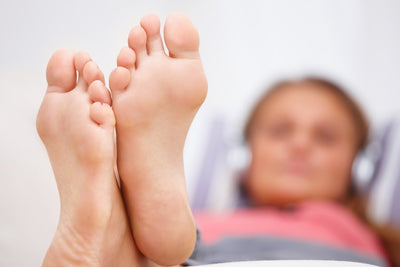
Plantar fasciitis is a common condition characterized by inflammation and irritation of the plantar fascia, a thick band of tissue that runs along the bottom of the foot, connecting the heel bone to the toes. This myofascial structure can become tight and restricted, often leading to intense heel pain, especially upon the first steps after waking up in the morning or after prolonged periods of rest. As someone focused on health and wellness, it's important to understand how plantar fasciitis develops and how manual massagers can play a role in alleviating the pain associated with it.
Plantar fasciitis typically develops due to repetitive strain on the plantar fascia. The resulting deep tissue tension and trauma to the fascia can lead to micro-tears and inflammation, causing the hallmark pain associated with plantar fasciitis. The condition can be caused by various factors such as improper footwear, excessive physical activity, weight gain, or even natural foot structure that is less than ideal. The pain arises because the inflamed fascia becomes less flexible and has reduced blood flow, resulting in discomfort and stiffness. This is where manual massagers such as Emu Therapy’s Spiky Ball Massage Roller can come into play.
Manual massagers, particularly those designed for foot use, can play a significant role in addressing the myofascial component of plantar fasciitis. These devices are designed to target specific deep tissues of the foot, working through layers of muscle to reach the fascia and connective tissues. They apply controlled pressure to release tension, improve circulation, and promote healing. This release can be especially beneficial in cases of plantar fasciitis where tension and myofascial restrictions contribute to the pain. Here's how they work:
- Pressure Application: Manual massagers usually feature knobs, rollers, or balls that users can roll under their feet. By applying pressure to the affected areas, the massager helps to stretch and manipulate the fascia. This can aid in breaking down scar tissue and adhesions that might have formed as a result of trauma to the plantar fascia and promoting the healing of micro-tears. Scar tissue can exacerbate pain and restrict movement, making its breakdown crucial for restoring proper function to the foot.
- Stimulation of Blood Flow: The rhythmic motion of using a manual massager stimulates blood flow to the affected area and can also aid in the removal of toxins that accumulate in the fascia due to inflammation and trauma. The manipulation of the tissue through the use of a manual massager stimulates blood and lymphatic circulation. Improved circulation enhances the delivery of oxygen and nutrients to the inflamed tissues as well as helps flush out toxins and waste products from the affected area, promoting a healthier environment for tissue repair and recovery.
- Muscle Relaxation: Plantar fasciitis often leads to muscle tension in the feet and calves. Manual massagers can target these muscles as well, helping to alleviate muscle tightness. With relaxed muscles, the overall strain on the plantar fascia is reduced and the resulting pain and discomfort are reduced.
- Fascia Release: Fascia is a fibrous tissue that “learns” to hold the body – internal organs, bones, muscles, and more – in a particular position. When the body is injured or misaligned, fascia can “learn” to hold the body in a new position that is restricted due to the improper placement of various parts. Manual massagers can assist in releasing fascial restrictions by applying controlled pressure to tight areas. This can lead to improved flexibility and reduced discomfort over time.
While manual massagers can offer relief for plantar fasciitis, it's important to note that they should be used as part of a comprehensive approach to managing the condition. This approach may include:
- Stretching Exercises: Gentle stretching of the calf muscles and Achilles tendon can help prevent further strain on the plantar fascia.
- Footwear: Properly fitting shoes with good arch support can alleviate stress on the fascia and aid in healing.
- Ice and Rest: Applying ice to the affected area and giving the foot adequate rest can reduce inflammation and pain.
- Consulting a Healthcare Professional: When trauma to the fascia has been severe or prolonged, it's advisable to consult a professional who specializes in myofascial release or physical therapy who can provide targeted guidance and therapies to address complex issues.
In conclusion, manual massagers can be a valuable tool in managing plantar fasciitis. They work by applying pressure, improving blood flow, relaxing muscles, and aiding in the release of fascial restrictions. However, they should be used as part of a holistic approach to managing the condition, which includes proper footwear, stretching, rest, and professional guidance. As a business promoting natural solutions to pain relief and wellness, Emu Therapy has incorporated the Spiky Ball Massage Roller and other Health Aides into our product offerings as beneficial additions to our range of natural health and wellness products.
Sources
Created using AI tools at ChatGPT
Edited by Stephen Eastmond


 {{/image.src}}
{{/image.src}}





